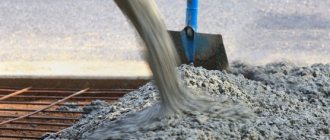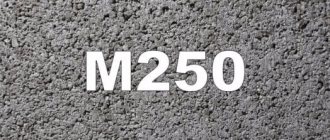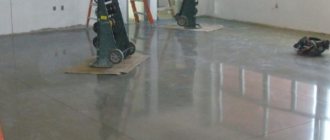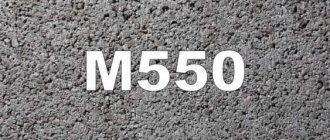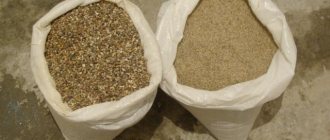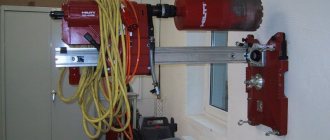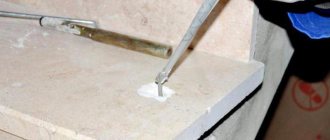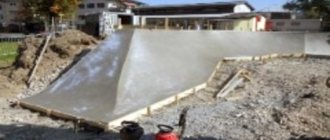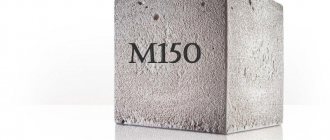Raw materials for production
The components for the production of concrete 600 are the same as for ordinary mixtures: cement, sand, crushed stone and water. The difference lies in the requirements for the purity and activity of these materials. To obtain a high-strength mixture, the raw ingredients are carefully prepared:
- Feldspathic or quartz sand - river, washed, grain size 2.4-2.6 mm. Depending on the required brand, deviations from 0.16 to 5.0 are regulated by GOST requirements.
- Cubic crushed stone - granite stone of fractions 5-10, 10-20, 20-40 mm is often used. For the manufacture of lightly reinforced structures, aggregate with a particle size of 7 cm is used. The strength index of crushed stone is M1200-1400.
- The binder is Portland cement. They take brands PC400 or PC500 D0 - this is the most expensive component of the mixture, its quantity and quality in combination with other materials determines the final strength of the concrete mixture.
- Water is clean from the central water supply or well.
- Additives that improve physical and mechanical properties - surface-active and plasticizing. The latter are useful for transporting the mixture to the construction site.
It is important to maintain the ratios between solid components. The main components are mixed in the following proportions:
| Brand of additive-free cement | M400 | M500 |
| Ingredient weight: | ||
| astringent | 1 | 1 |
| sand | 0,9 | 1 |
| crushed stone | 2,1 | 2,3 |
In addition to the concept of concrete grade, the SNiP 2.03.01-84 standard provides for a strength class, designated for M600 as “B45 concrete”. The combination of numbers in this case means that 95% of products from such a mixture can withstand a pressure of 45 MPa (459 kg/cm2). The average for this strength class is 589 kg/sq.m. cm.
Current classification standard
Today, when carrying out production and pre-sale preparation, they use the state all-Union standard 31108-2003. According to it, technical aspects are encrypted in Russian letters, as well as Roman and Arabic numerals. The code begins with the name, then the general part “CEM” is indicated and each mixture is distinguished by an individual alphanumeric designation, which depends on the type of powder.
To make it easier to decipher the values on the bags, a summary table is presented.
| Abbreviations denoting subtype | Type of powder | Note | Scope of application | Directions in which you should not use |
| CEM I | Portland cement (PC) | No mineral additives | Pouring monoliths from concrete mixture and reinforced concrete structures | In special types of structures |
| CEM II | PC with mineral additives | For materials, the percentage of minerals is indicated (letters A or B) | — | |
| CEM III | Slag Portland cement (SPC) | Reinforced monoliths of above-ground and underground, including underwater locations | Production of frost-resistant concrete, and also cannot be a component of buildings subject to fluctuations in humidity | |
| CEM IV | Pozzolanic (PPS) | Monoliths of underground and underwater location | The same as for ShPC, but in addition to humidity fluctuations, the hardening procedure in a dry environment is also inaccessible | |
| CEM V | Composite | Determined based on the nuances of production | — |
Presentation with brief characteristics
Each of the powders listed in the table classification has unique parameters that are relevant for detailed consideration.
- CEM I. Has an increased rate of achieving optimal cement strength at the initial stages - during the first day, about 50% of the brand value. The proportion of minerals in such powder does not exceed 5%.
- CEM II. One of the cases when construction powder may have an increased volume of minerals - from 5 to 35%. The time during which optimal and ultimate compressive strength is gained decreases in proportion to the increase in the percentage of minerals contained.
- CEM III. The key element is granulated slag in an amount from 36 to 65%, obtained from iron casting.
- CEM IV. Contains silica (“MK”/”M”), fly ash (“Z”) and pozzolans (“P”) - from 21% to 35%.
- CEM V. Combination of clinker with fly ash (11-30%) and granulated slag (11-30%).
Based on the various additives added to the powder, they are displayed in letters after indicating the subtype A or B.
Class affiliation
Then the strength class, previously characterized by brand, is written.
There is experimental technology to determine this parameter.
- A standard blank is being created.
- A vibration load is applied to each product.
- The samples are removed from the mold on the third day and immersed under a layer of water until the end of 4 weeks.
- Three blanks are removed and checked under pressure. The value of the average resistance to this type of load becomes the strength class for the powder.
In a similar way (in tabular format) we present popular powders by class. The brand affiliation (according to the old standard) to which a specific building material corresponds will also be indicated.
| Class affiliation | Nearest brand affiliation | Strength indicator after 4 weeks, mPa | Areas of operation |
| 22,5 | M300 | ~2,206 | For individual construction, if there is no excessive load on the structure |
| 32,5 | M400 | ~3,187 | Low-rise buildings, monolithic concreting and creation of reinforced concrete products |
| 42,5 | M500 | ~4,167 | Monolithic construction and reinforced concrete products, when subsequent work is carried out under heavy load |
| 52,5 | M600 | ~5,148 | Hydrophobic building material for bridge supports or other military engineering facilities |
Also among the main marking parameters is the speed level of hardening: N - normal, B - fast-hardening. The specified list ends with the numbering of the state standard, using which the code was created.
Perhaps one of the distinctive features of standard 10178-85 is a different indication of the proportion of additives in the powder: D0 - no more than 5%, D20 - 20%. The remaining parameters were mentioned in one way or another within the framework of this article.
Properties and characteristics of high-quality concrete
The increased quality of raw materials affects the properties of the concrete made from it; it gives the mixture special capabilities. What stands out is the problem-free duration of contact of M600 with the aquatic environment and its resistance to intense loads on structural elements. Achievements are based on the following indicators of concrete mixture and hard cement:
- Mobility of the solution - ability to flow, workability. Depends on the amount of water and plasticizer content. The total degree of ease of filling forms is 5. The mobility indicator of concrete of strength class B45 is at a high level - P3-P5.
- Water resistance is the ability of a product to withstand water pressure. There are ten categories of the indicator: from W2 to W20 with a multiplicity of 2 kg/cm2. The characteristics depend on the W/C - moisture-cement ratio and the pore structure of the monolith. For M600, the indicator varies within W12-W18.
- Frost resistance is a characteristic of the influence of temperature changes on the ability of concrete structures to maintain their original strength. The physical meaning is the number of cycles of freezing and thawing of blocks. Hardened B45 solutions are characterized by high values - F 200-400.
- The density of M600 concrete varies between 2.3-2.5 t/m3.
READ Composition and main characteristics of M500 concrete
The high-strength monolith quickly sets and hardens at a normal temperature of 20-25ºС, and heat treatment reduces the time to gain strength. Has increased surface wear resistance.
Technical characteristics of cement grade 600 and its scope
Due to its high strength, concrete made from this brand of cement is called “military”. This name is not accidental. It directly indicates the main area of use of such concrete. Most often it is used in the construction of military facilities and other special-purpose structures. You can study M700 cement, find out its characteristics and properties.
There are several varieties of M600 cement, the characteristics of which are reflected in the markings of each group:
- “B” – quick-hardening cement, used for emergency and other urgent work;
- “N” – “normalized”. For production, clinker of strictly standardized composition is used;
- “PC” – ordinary cement “Portland cement”;
- “BC” – “white cement”. Widely used for interior and exterior wall decoration;
- “PL” – “plasticized”. Characterized by good plasticity and frost resistance;
- “SS” – sulfate-resistant. Resistant to salt water and other aggressive environments with a high sulfate content;
- “GF” – “hydrophobic”. Frost-resistant and highly plastic material;
- "ShPC" - Portland slag cement. In addition to crushed clinker, granulated blast furnace slag is added to such cement in an amount of 30–65% of the total mass. Products made from such cement resist high temperatures well, but harden very slowly (4-5 weeks);
- “VRTs” – The most “emergency” cement. Due to its ability to expand and good water permeability, it is used for sealing joints in hydraulic structures. Can be used to seal leaks in ship hulls. “Setting” of this material occurs within 4-10 minutes.
Areas of application of durable mixtures
The high quality characteristics of B45 predetermine its use in critical structures and structures where construction is carried out for centuries. The objects being constructed must withstand the loads of any elemental impact and the most aggressive environment. Such megaobjects are:
- large-scale and complex structures - supports and spans of bridges, overpasses, where high compressive strength is required;
- structures of hydraulic engineering facilities in contact with water: reclamation and bank protection, hydroelectric power stations, barrier dams, locks and dams - heavy concrete M600 almost does not absorb moisture, it is used wherever the water level is unstable;
- bank vaults and military bunkers, strategic structures and tunnels, chutes and spillways, metro stations - objects operated in difficult conditions;
- elements of chemical, defense and space industries, nuclear power units, reactors and stations, radioactive waste storage facilities.
READ Concrete M300: characteristics, composition and preparation
Good tensile strength is a sought-after characteristic of M600 in the construction of airfields, road surfaces, concreting floors and foundations of production workshops. The properties of B45 to prevent the penetration of radioactive radiation are used in the construction of biological protection of objects.
Advantages of high-quality cement
Cement grades M600 and M700 are indispensable in the construction of critical buildings and structures that require high resistance to moisture, aggressive and mechanical influences. Without this material it is impossible to quickly and efficiently carry out complex repair and restoration work. These types of binders are used in the construction of foundations for powerful buildings and equipment, and in bridge construction.
In addition, high-grade cement differs from conventional types of binders:
- composition of components that provides significant strength to concrete and short hardening times;
- high resistance to ultraviolet radiation, moisture, sudden temperature changes;
- excellent ductility and resistance to cracking;
- the ability to use kaolin and chalk in the production process, containing a low percentage of iron and manganese oxides, that is, to obtain a white material.
In turn, white cement M600, M700 has advantages, the importance of which cannot be overestimated. Along with the main characteristics, a concrete mixture based on clarified binder has:
- the ability to create a beautiful, completely smooth surface; this property is used in compositions for self-leveling floors and in the creation of decorative elements in design work;
- the ability to use a wide range of colorful pigments, which gives enormous scope for the implementation of a variety of design solutions.
Gray cement is deprived of such advantages, since its “native” shade will not be able to convey the pure color of the color, but will make it cloudy and dirty.
Features of concreting with high-quality cement
The rapid setting of the M600 mixture creates difficulties when transporting and laying the solution into formwork. To eliminate them, special rules are applied. Here are some of them:
- transportation from the factory using special equipment with constant mixing - a mixer;
- selection of the shortest route for delivering concrete mixture to the site;
- prompt unloading at the construction site with simultaneous laying;
- high level of preparedness of concrete workers.
Another aspect of the quick setting of the mortar is the ability to remove the formwork a few hours after pouring, which allows construction to be carried out at an accelerated pace in a short time. Steam treatment of the laid monolith is usually abandoned.
The use of selected materials for B45 concrete reduces the weight and profile sections of the structure without compromising its strength. The high grade of the monolith does not imply its non-shrinkability - it is the same as that of ordinary concrete of medium hardness.
M600 mixture (waterproofing)
print version
TU 5745-117-46854090-2001
Price: price list.
The dry waterproofing mixture consists of tensile cement, fractionated quartz sand and modifying additives.
APPLICATION AREA
Designed for the manufacture of underground structures, tunnels, including subways, basements, underground garages, swimming pools, wastewater treatment plants, sewers, water supply structures, during the reconstruction and repair of flooded or damp premises. The solution prepared from this mixture is used without any additional waterproofing. At negative temperatures (up to - 100 C), it is possible to use frost-resistant additives.
MATERIAL PROPERTIES
Provides impermeability to water, salt solutions and petroleum products, reduces the destruction of building structures, increases the strength and wear resistance of the material, has increased compressive and bending strength, and increased corrosion resistance. The mixture does not contain toxic components, is explosion and fireproof. The dry mixture has a hygienic certificate.
TECHNICAL SPECIFICATIONS
- Compressive strength 60 MPa
- Tensile bending strength 9 MPa
- Frost resistance of at least 300 cycles
- Density of the mortar mixture 2.1 – 2.2 g/cm
- Setting time: start no later than 3 hours
- end no later than 5 o'clock
- Free expansion of at least 0.2%
- Water permeability grade 12 (water pressure up to 1.2 MPa).
SURFACE PREPARATION
The base on which the solution is applied must be clean, strong, without delamination and crumbling areas, without greasy stains. Clean the surface from dust and thoroughly moisten with water.
PREPARATION OF WATERPROOFING COMPOSITION
Mix the dry mixture with water (1.8-2.0 liters per 10 kg of dry mixture) and mix thoroughly.
The water temperature should not be lower than +15 C.
APPLYING THE SOLUTION
The solution is applied manually or with a mortar pump, depending on the purpose:
- at a water pressure of no more than 0.1 MPa - with a spatula in one layer with a flow rate of 3.5-4.5 kg/m2
- at a pressure of up to 1.2 MPa - with a spatula in two layers with a consumption of 6-10 kg/m2 (the second layer is applied after the first, after 5-6 hours. Before applying the second layer, the surface should be moistened).
The thickness of the applied layer must be at least 5 mm.
The applied layer must be rubbed thoroughly.
CURING CONDITIONS
After completing the work for 5-10 days, it is necessary to maintain moist hardening conditions on the surface of the structure by periodic watering (every 12 hours) or covering it from drying out (plastic film, wet burlap, tarpaulin).
PACKAGE
Paper bags of 25 kg.
STORAGE
Store in dry places, in tightly closed bags, avoid exposure to moisture.
Guaranteed shelf life in a dry place is 6 months.
" Return
Monitoring the compliance of the solution with class B45
The use of M600 in critical structures is accompanied by constant quality control of concrete at all stages of its production. Supervision is also carried out over compliance with the regulations for laying the mixture into the body of the structure. Checks are carried out according to the following rules:
- Acceptance of concrete is carried out in batches prepared from the same raw material of the established composition using a single technology. The amount of mass being tested is determined according to GOST-18105; usually the volume does not exceed the replacement output of the concrete mixer.
- The workability of the solution is checked in each batch once per shift no later than 15 minutes after production and 20 minutes upon delivery to the consumer. From each released volume, the average density and strength of the concrete mixture is checked. Other characteristics (frost resistance, water resistance) are determined according to the technical specifications for the structures being manufactured.
- At the work site, the concrete mixture is accepted by volume: the loaded volume is reduced by the compaction index during transportation as agreed upon by the manufacturer and the consumer.
- The user has the right to conduct supervisory checks of the quality and quantity of concrete mortar according to GOST-10181 methods.
READ Characteristics and scope of concrete grade M450
The manufacturer is obliged to inform the consumer, upon his request, of the test results no later than 3 days after they were carried out. If the quality indicator does not comply, a message about this is sent to the facility under construction on the same day. Today, the consumption volumes of high-quality concrete grade M600 with strength class B45 are still small, but they are constantly increasing, which indicates the growth of capital construction and the country’s economy as a whole.
Non-additive cement
The most important element in preparing concrete for making paving slabs, wall stones, concrete countertops and MAF is the binder (binder) which is cement. The quality of the finished product will depend 50% on the correct choice of cement. Primary requirements :
- Type of cement – Portland cement (PC)
- The cement must be fresh, i.e. recently made. Each month of storing ready-made cement in bags reduces its strength by several%. The freshness of cement can be partially assessed by its bulk density, from 1200-1300 kg/m3 for fresh cement to 1500-1700 for old cement.
- The grade of cement is not lower than M400 (PTs 400), but it is better to use cement grade M500 (PTs 500) then the strength and durability of the tiles will be higher.
- The cement must be WITHOUT ADDITIVES !!!. The presence of mineral additives in cement (fly ash, granulated blast furnace slag, pozzolana or other mineral fillers permitted by GOST) will lead to unpredictable results when interacting with plasticizing additives and dyes and, as a result, negatively affect the strength and appearance of the finished product.
Let's decipher the symbol of cement produced according to 2 types of GOST. Cements produced not in accordance with GOST are not considered for purchase and use at all, as the result is absolutely not predictable.
According to GOST 10178-85, the symbol for cement consists of:
- — names of the type of cement – Portland cement (PC), slag Portland cement (SPC).;
- — grades of cement (strength);
- — designations of the maximum content of additives in Portland cement: D0, D5, D20;
- - designation of fast-hardening cement - B;
- - designations for plasticization and hydrophobization of cement - PL, GF;
An example of a symbol for Portland cement grade 400, with additives up to 20%, quick-hardening, plasticized, manufactured in accordance with GOST: Portland cement 400-D20-B-PL GOST 10178-85.
Since January 1, 2008, some Russian cement factories have switched to cement production in accordance with GOST 31108-2003. According to GOST 31108-2003, the designations of cements are changing. The symbol for cement consists of:
- - names of cement (CEM I - Portland cement, CEM II - Portland cement with mineral additives)
- - Portland cement with mineral additives is divided into subtypes A and B - for subtype A the amount of mineral additives is limited from 6% to 20%, for type B - from 21% to 35%;
- - abbreviated designation of cement, including the designation of the type and subtype of cement and the type of additive (granulated slag is designated by the letter Ш; pozzolana - P; composition of slag and pozzolana (tripoli, opoka) - K (Ш-П));
- — strength class (22.5; 32.5; 42.5 and 52.5, which means the minimum compressive strength at 28 days, MPa);
- - subclass designations (compressive strength at the age of 2 (7) days - N (normally hardening) and B (fast-hardening), except for class 22.5);
- - designation of the standard to which the cement complies.
Examples of symbols: Portland cement with slag from 6% to 20%, strength class 32.5 (analogous to M400), quick-hardening: TsEM II/A-Sh 32.5 B GOST 31108-2003;
ATTENTION ! According to GOST 31108-2003, it is permissible to add mineral components to CEM I grade cement (i.e., additive-free cement!). Therefore, it is preferable to use cement produced in accordance with GOST 10178-85

